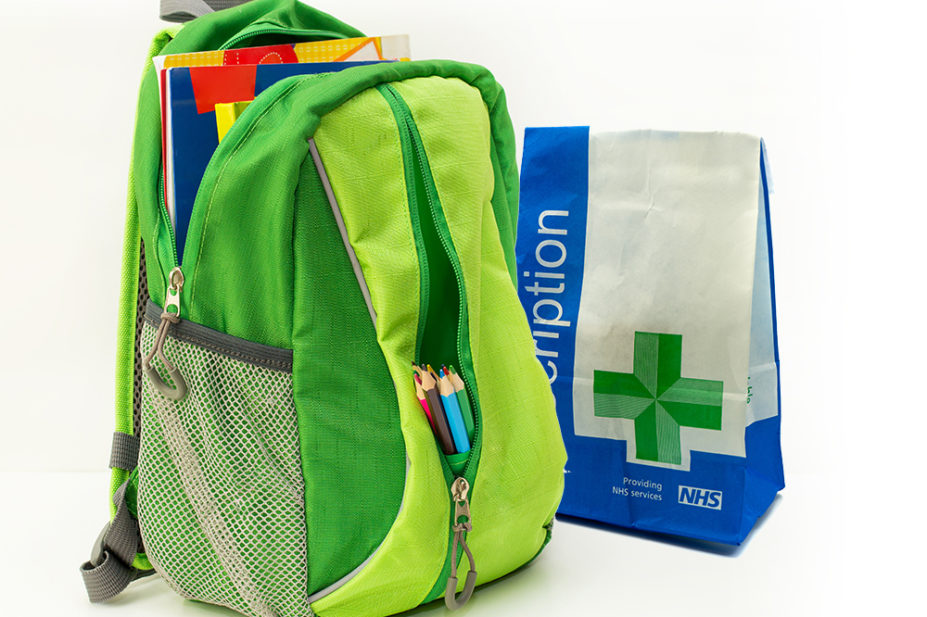
Mclean/Shutterstock.com
Take a look at the professionals featured across The Pharmaceutical Journal and you’ll see pharmacy proving its worth. Pharmacists are both broadening their skills in their portfolio careers, and developing specialist ones in new and exciting settings to improve the lives of patients across the UK.
But there is one patient group that has been left behind. Despite having a clear need for our medicines support, many children and young people in special schools are not yet feeling our full benefit.
In England alone, there are around 1.32 million children and young people with a special educational need or disability (SEND), and around 9.3% of these pupils attend a special school for the support that may not be available to them in a mainstream school[1,2]. Many special school pupils have more complex medical needs than those in mainstream schools and may need to take medicines during school time for their conditions, as well as for others, such as asthma, epilepsy, diabetes and attention deficit hyperactivity disorder (ADHD).
In 2014, education reforms that recognised these pupils’ greater needs sought to improve their care: special schools’ governing bodies became required to make arrangements to support pupils with their medical conditions at school[3].
By law, governing bodies must properly understand and effectively support pupils’ medication conditions and medical needs to give them full access to their education, including school trips and physical education. To do this, they must consult the pupils’ parents, and health and social care professionals, and record these needs in the child’s education, health and care plan (EHC)[4].
Surely, pharmacists are the most appropriate healthcare professionals to consult about these needs and yet, within the complex commissioning structure for special school pupils, there has never been a formal pathway to promote or support the need for a pharmacy-led medicines optimisation service in this setting.
This commissioning structure sees local authorities make joint arrangements with their health partners for the education, health and care of their pupils, but there is no standardised approach for this, so the way in which this model is delivered varies greatly across the nation. There are even big differences between local areas, where some schools have full collaborative working between their local authority and health partners (primarily specialist community nursing services), while other schools have little or no support, left to fund their own health provisions.
During the pandemic, special schools have remained open — made possible by bubbles and testing — so it is as important as ever that no child or young person’s health at school should be determined by a postcode lottery.
It is pharmacists who can provide winning medicines support for everyone — so here is why we are the solution to special schools’ medicine challenges.
Difficulty with medicines
Individual schools are responsible for interpreting guidance from the Department for Education and for putting medicines management into place[3]. However, pupils may require their medicines (sometimes off-label or unlicensed) to be administered with complex dosing regimens for specific conditions, or for managing acute episodes. The medicines may be administered by specialist devices, such as intrathecal pumps, enteral feeding tubes, infusion pumps or syringe drivers. Despite this medical complexity, there is no legal requirement for special schools to employ a school nurse. This means that medicines management is often the responsibility of teachers and teaching assistants, who play a significant role in administering medicines, storage and other healthcare-related matters during school hours[5].
But in a 2017 survey across primary, secondary and special schools in the UK, headteachers acknowledged that staff responsible for medicines often lack sufficient medical expertise for these roles[5]. The survey also identified vast differences between how individual schools managed medicines and how they interpreted the government’s policy guidance[3,5].
The study consulted other important stakeholders too. Parents were clear on their need for schools to understand their child’s condition, and they expressed concern that doses were being given late or being missed completely. Healthcare professionals, too, were worried about missed doses, and they aired their frustration about the inconsistency of medicines management policies across different schools[3].
Medicines management is missing the mark across all types of schools — fewer than half of parents and healthcare professionals are satisfied with how medicines are dealt with in this setting — and this is particularly concerning for special schools, where medical conditions and needs are often more complex[5].
While there are little data on these issues specifically in special schools in the UK, those in the United States have faced similar problems: back in 2000, one paper looking at medicines administration by school nurses in the United States recommended that they consult with a pharmacist, who could provide valuable advice on all things medicines[6].
Pharmacy teams in special schools
In 2018, a dedicated pharmacy team for children and young people put their skills to the test in this setting. The team from Kent Community Health NHS Foundation Trust undertook a pilot study in a special school, in which specialist pharmacists supported the safe and effective management of medicines in children and young people, and minimised the risk of errors (data on file).
The pharmacists made sure the children’s medicine administration records (MARs) were safe, accurate, current and fit for purpose, by aiming to meet 25 standards inferred from the Royal Pharmaceutical Society’s MAR guidance; for example, logging information, such as full name, date of birth and correct drug name[7].
Before the pharmacy intervention, only 9 out of the 25 MAR standards were being met. After the intervention, all 25 standards were being met at least some of the time (data on file). The standards include logging the child/young person’s allergy status, who the administration was given and written by, who it was checked by, the formulation of the medicine and whether legible notes had been used. Additionally, the number of standards being met 90% of the time increased from three to seven; this emphasised the need for ongoing collaboration between specialist pharmacy services and special schools (data on file).
The pharmacy team made appropriate interventions, including making deprescribing recommendations to the special school. For example, many children had not required salbutamol for years, despite it saying so in old emergency plans. Parents were contacted, who confirmed the medicine was not needed, and the inhalers were removed, leading to a 60% reduction in inhalers stored across the school (data on file).
Outdated emergency plans for epilepsy, asthma and anaphylaxis were a common issue previously identified in work by the Kent pharmacy team. Plans were updated and new prescriptions were given, which improved safety. Interventions were made where subtherapeutic doses of emergency epilepsy medicines were identified. Unlabelled or illegible labels were replaced. Children finding it difficult to swallow tablets were found alternative means of administration. Inaccurate MAR charts were addressed. And a pharmacist intervention led one child’s GP to review and stop a medicine, and change the type of enteral feed, which eliminated the child’s problems with excessive acid secretion.
Why pharmacists are the solution
The pharmacy team’s skills were perfect for this setting: they could listen, explain, advise and question. What if community pharmacists linked up with children and young people, and their families and schools to provide support like this?
Medicine reviews and support
Community pharmacists’ medicines use reviews (MURs) and new medicines service (NMS) consultations, for example, seek to improve medication regimens and, ultimately, disease outcomes. And there is some evidence that community pharmacy groups are already working with children and young people in general: in 2017, a study across 76 community pharmacies in England identified that 23.7% had undertaken an MUR with a child and their carer, while 28.9% had undertaken the NMS with this patient group[8].
There’s a clear need for this kind of interaction with pharmacists: the community pharmacists who took part in the study explained that children and their carers were eager for medicines information about the timing of doses; whether it was necessary to take a supply of medicines to school; whether to take their medicines with or after food; whether the taste could be improved; and about potential side effects to look out for/which to ask the school to look out for[8]. This work should be pushed further — the authors of the study suggest there is scope to extend this work into a specific paediatric medication review for all children[8].
Pharmacists can support the safe and effective administration of medicines in school too. Kent Community Health NHS Foundation Trust’s pilot showed just how important a standardised MAR chart is to this goal (data on file). Community pharmacists have access to robust dispensing software tools to provide a repeat prescription dispensing service; minimise waste; dispense separately labelled supplies for home and school where appropriate; and provide up-to-date MAR charts to parents, carers and schools.
Medicines information and advice
Special schools will not always have access to a specialist pharmacist, as they did in the study, but community pharmacists know where the important medicines information is. They can share resources such as leaflets and dispensing labels, and advice for parents and schools on dosing intervals; how to administer medicines (particularly those delivered by specialist medical devices); keeping emergency medicines for asthma and anaphylaxis at school; and off-label and unlicensed use of medicines, when appropriate[9].
What community pharmacists can do to help now
Community pharmacists don’t need to wait until a child or young person with an SEND presents in their pharmacy for help: they can proactively identify the people who need them. For example, they can promote MURs and the NMS for the children and young people who visit the pharmacy.
Community pharmacists can communicate all interventions they have made with a child or young person’s parents or carers, their healthcare professionals (such as their GP, consultant or specialist nurse) and, importantly, the health lead at their special school to make sure changes are noted on the child’s EHC.
They can encourage children and young people who are competent and confident with their medicines to self-administer, and support them to independently manage their medicines at home and in school to improve compliance and adherence.
Importantly, community pharmacists should engage with their local authority and NHS community health service trust pharmacy team to make interventions and provide MAR charts, all the while building rewarding collaborative working relationships.
And, where possible and appropriate, they should liaise with GPs for separate prescriptions for supply of medication for home and school. This will enable the child’s school to receive a unique supply that is correctly labelled for the duration of the school term, particularly when a pupil may be using residential facilities, and especially if home and school are not local to each other.
A national programme
Community pharmacists cannot standardise medical support for this patient group on their own. We need specialist pharmacy services for special schools; this calls for an overhaul of the existing commissioning processes and funding for medicines support across the nation.
In September 2019, five years on from the last education reforms for children and young people with special needs, the government promised a major review of how their education and care system has evolved to join up the patchwork of support across the UK[10].
The review is yet to report, but until this vision of full medicines support for all children with an SEND is realised — no matter which local authority they are a part of — community pharmacists can be the difference.
Nirusha Govender, senior pharmacist for children, young people & dental services, Kent Community Health NHS Foundation Trust
In October 2020, Kent Community Health NHS Foundation Trust won transformation funding from Health Education England London and the South East, for a medicines optimisation project that will see a specialist pharmacy service support special schools to achieve the best care for all children and young people in special schools.
- 1Special education needs and disability: an analysis and summary of data sources. Department for Education. 2020.https://assets.publishing.service.gov.uk/government/uploads/system/uploads/attachment_data/file/882802/Special_educational_needs_and_disability_-_an_analysis_and_summary_of_data_sources.pdf (accessed Feb 2021).
- 2Children — research and statistics. Mencap. https://www.mencap.org.uk/learning-disability-explained/research-and-statistics/children-research-and-statistics (accessed Feb 2021).
- 3Supporting pupils at school with medical conditions: statutory guidance for governing bodies of maintained schools and proprietors of academies in England. Department for Education. 2014.https://www.bl.uk/collection-items/supporting-pupils-at-school-with-medical-conditions-statutory-guidance-for-governing-bodies-of-maintained-schools-and-proprietors-of-academies-in-england (accessed Feb 2021).
- 4Children with special educational needs and disabilities. Gov.uk. https://www.gov.uk/children-with-special-educational-needs/extra-SEN-help (accessed Feb 2021).
- 5Bellis JR, Arnott J, Barker C, et al. Medicines in schools: a cross-sectional survey of children, parents, teachers and health professionals. bmjpo 2017;:e000110. doi:10.1136/bmjpo-2017-000110
- 6McCarthy AM, Kelly MW, Reed D. Medication Administration Practices of School Nurses. Journal of School Health 2000;:371–6. doi:10.1111/j.1746-1561.2000.tb07277.x
- 7Principles of safe and appropriate production of medicine administration charts. Royal Pharmaceutical Society. 2009.https://www.rpharms.com/Portals/0/RPS%20document%20library/Open%20access/Hub/production-medicine-administration-charts.pdf (accessed Feb 2021).
- 8Aston J, Wilson KA, Terry DRP. Children/young people taking long-term medication: a survey of community pharmacists’ experiences in England. International Journal of Pharmacy Practice 2017;:104–10. doi:10.1111/ijpp.12371
- 9Leaflets. Medicines for Children. https://www.medicinesforchildren.org.uk/search-for-a-leaflet (accessed Feb 2021).
- 10Major review into support from children with special educational needs. Department for Education. 2019.https://www.gov.uk/government/news/major-review-into-support-for-children-with-special-educational-needs (accessed Feb 2021).


